C.6.a - 71 Rainey St - Citizen Comment — original pdf
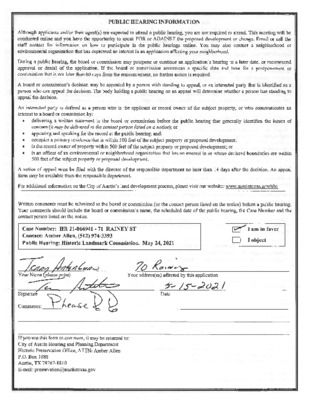
Backup

Backup

HISTORIC LANDMARK COMMISSION PERMITS IN NATIONAL REGISTER DISTRICTS MAY 24, 2021 PR-2021-072218; HR-2021-066900 OLD WEST AUSTIN NATIONAL REGISTER DISTRICT 2308 WOODLAWN BLVD. C.7 – 1 PROPOSAL Demolish 1940 contributing house due to fire damage. PROJECT SPECIFICATIONS The house was significantly damaged by a fire on March 12, 2021 that occurred during a renovation project. The fire burned from at least 3:15 to 7:31 A.M., when Austin Fire Department declared it under control. At the peak, nearly 70 firefighters responded. The fire destroyed the metal roof of the central, two-story volume of the house, burned through the floor structure on multiple levels, and resulted in extensive fire, smoke, and water damage. In addition to photos in this report and supporting documentation from the applicant, please see the following news coverage: • Statesman.com/story/news/2021/03/12/firefighters-tackle-blaze-former-long-estate-mansion-central- austin/4662038001/ • Cbsaustin.com/news/local/two-alarm-fire-at-central-austin-house-causes-street-closures • Twitter.com/AustinFireInfo, 3/12/2021, from 3:49 A.M. to 7:31 A.M. when the fire was declared under control The current application is solely for demolition due to life safety concerns. Per Land Development Code § 25-11-213 (J), review of new construction in a National Register district is not required prior to issuance of a demolition permit in cases where “the building official determines that demolition or relocation is necessary for reasons related to public safety.” Plans for new construction will be submitted to the Commission at a future date. The applicant intends to rebuild the front of the house as it existed prior to the fire, including reuse of the columns. ARCHITECTURE RESEARCH This brick Neoclassical mansion consists of a central, two-story portion flanked by symmetrical one-story wings. The central portion has a full-façade porch with Doric columns supporting an entablature and a full-width balcony with decorative railing. The wings each have a slightly recessed hyphen terminating in a front-gabled volume, with quoins at the corners and cornice returns and cupolas at the roofs. The central front door has an elliptical transom and sidelights, and multi-light windows on the front of the house have operable shutters. The house has a rear addition to the northern wing, including a garage, and an octagonal addition at the center rear. The house was built in 1940 for Frank W. and Olivia M. Woolsey. Frank Woolsey, born in 1893, occupied the house until his death in 1963. An insurance executive, he was one of the founders of the Austin Mutual Life Insurance Company in 1921. He served as president of two successor …

Field Report Date: Project: Present: Notes May 10, 2021 Time: 8:30 AM 2308 Woodlawn Blvd, Austin, Texas Project Number: 21821000 David Heitman Kevin Istas Scott Allen First Onsite First Onsite OPN Architects 1. General comments: a. The roof is gone over the center section of the building due to the fire and not reviewed above the second-floor level. The roof structure was wood truss construction and failed, fire appears to have started near the first level front door. The fire burned down to Lower Level and up to the second floor, complete route not known at this time. Daylight is seen through the walls and roof structure; wet wood materials are visible. Concern for mold in the walls and concealed areas of the structure. Large areas of the second floor level are open to daylight and weather. b. Building codes will need to be checked for the new sprinkler system requirements in the building with review of the c. Marble and granite used throughout the building as floor material and base. Location of the removed stone materials d. No kitchen cabinets installed; areas appeared to have been in the rough in stage of a remodeling project as only the Authority Having Jurisdiction. not seen on site. range was seen on site. e. Lutron dimming system for the lighting used throughout the building. f. No temporary lighting in the building. g. Wood inlayed floors and oak floors on the main and upper level. h. Copper standing seam roof, gutters and downspouts. 2. Lower Level: a. Octagon Art Space – The concrete floor is over precast concrete planks on concrete piles at the perimeter. The floor slab over the precast has failed, water proofing membrane visible and damaged and space has been underwater at least to above the head of the doors. Structural engineer needed to determine if movement has occurred on the upper levels. b. Mold on the plaster ceiling and walls surfaces. c. Stair to the Lower Level has moved up and needs complete replacement. Debris is on top of these planks and the stair stringer is too high causing the treads to slope back. Could not view the condition of the concrete planks and the void between the structural precast planks and the earth members below. Page 2 of 15 d. Space not shown on the Lower Level floor plans provided, seen through the damaged floor and located to …
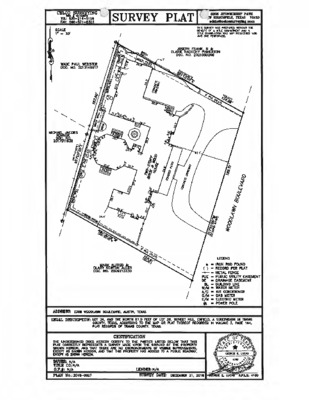
Backup
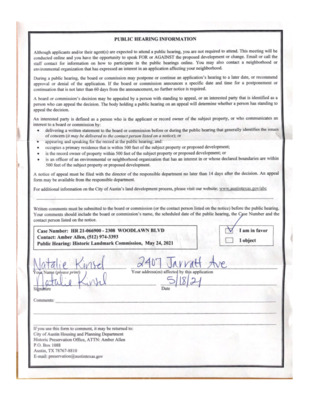
Backup

HISTORIC LANDMARK COMMISSION PERMITS IN NATIONAL REGISTER HISTORIC DISTRICTS MAY 24, 2021 SB 21 054392, 21 055812, 21 055829 CONGRESS AVENUE NATIONAL REGISTER HISTORIC DISTRICT 600 CONGRESS AVENUE C.9 – 1 PROPOSAL Install 3 signs on a noncontributing building. PROJECT SPECIFICATIONS 1) Install a non-illuminated, 5.95-square-foot aluminum blade sign at the building’s east elevation. 2) Install an externally illuminated 20.02-square-foot flush-mounted aluminum sign above the first-floor tenant entrance at the building’s east elevation. It is 2’-11” in height. 3) Install a non-illuminated 19.88-square-foot flush-mounted aluminum sign at the southeast corner of the building above a first-floor takeout window facing the intersection of Congress Avenue and E. 6th Street. It is 4’-5 ½” in height. STANDARDS FOR REVIEW The City of Austin’s Historic Sign Standards are based on the Secretary of the Interior’s Standards for Rehabilitation and are used to evaluate projects in National Register Historic Districts. The following standards apply to the proposed project: The Commission allows one sign per building, unless the building has multiple tenants; in this case, the Commission may allow one sign per façade module if the façade modules correspond to tenant spaces. The Commission may also allow one sign for each street frontage if the building is at an intersection. The proposed project includes three signs. Two are located on the same elevation, and one at the corner (facing the intersection). The maximum size for signs depends on the sign type. Projecting (blade) signs: 6 square feet. Flush-mounted signs: 7% of the overall façade area, with a maximum height of 2 feet and a maximum size of 20 square feet. Large commercial buildings (over 3 stories): Cumulative signage may not exceed 40 square feet per façade and must comply with a signage plan for the building. The proposed blade sign is about six square feet in area. The proposed flush-mounted signs are about 20 square feet in area per sign. The corner sign is 4’-5 ½” in height, while the illuminated sign is 2’-11” in height. The signs will be installed on a large commercial building with existing signage; the area of existing signage has not been calculated. Use simple shapes, such as rectangular or oval signs. The Commission recommends painted wood or metal signs with matte finishes for all signs; plastic, reflective materials, and unfinished surfaces are not allowed. The proposed signs are all roughly rectangular. They are made of painted aluminum, with either …

VICINITY MAP N.T.S. NORTH AERIAL VIEW N.T.S. KRISTEN HAMILTON - 678-725-8852 KHamilton@chandlersigns.com AMY McCANN - 210-349-3804 AMcCann@chandlersigns.com 0623131AR3 1 of 5 #4547 600 CONGRESS AVE STE C150 AUSTIN, TX KRISTEN HAMILTON A. MCCANN H. PAYNE 08/30/19 -R1(10-16-19)HP: INCREASED SIZE OF CHANNEL LETTERS. R2(02/09/2021)HP: UPDATED BULKHEAD PER SURVEY. NON ILLUMINATED SIGNS. UPDATED FLOOR PLAN AND ELEVATIONS. R3(04/23/2021)HP: UPDATED SIGN SQUARE FOOTAGE. National Headquarters 14201 Sovereign Road #101 Fort Worth, TX 76155 (214)902-2000 Fax(214)902-2044 San Antonio West Coast Northeast US Florida Georgia South Texas 17319 San Pedro Ave Ste 200 San Antonio, TX 78232 (210)349-3804 Fax (210)349-8724 3220 Executive Ridge Dr Ste 250 Vista, CA 92081 (760) 734-1708 Fax (760) 734-3752 2301 River Road Ste 201 Louisville, KY 40206 (502) 897-9800 Cell (502) 554-2575 2584 Sand Hill Point Circle Davenport, FL 33837 (863) 420-1100 Fax (863) 424-1160 111 Woodstone Place Dawsonville, GA 30534 (678) 725-8852 Fax (210) 349-8724 PO BOX 125 206 Doral Drive Portland, TX 78374 (361) 563-5599 Fax (361) 643-6533 SITE PLAN A B A C B " 4 - ' 8 ' C ' . O B . " 1 - ' 2 1 E D A L B . O B . " 3 - ' 7 N O C I . O B . C B BUILDING ELEVATIONS SCALE: 3/32" = 1'-0" 0623131AR3 2 of 5 #4547 600 CONGRESS AVE STE C150 AUSTIN, TX KRISTEN HAMILTON A. MCCANN H. PAYNE 08/30/19 -R1(10-16-19)HP: INCREASED SIZE OF CHANNEL LETTERS. R2(02/09/2021)HP: UPDATED BULKHEAD PER SURVEY. NON ILLUMINATED SIGNS. UPDATED FLOOR PLAN AND ELEVATIONS. R3(04/23/2021)HP: UPDATED SIGN SQUARE FOOTAGE. National Headquarters 14201 Sovereign Road #101 Fort Worth, TX 76155 (214)902-2000 Fax(214)902-2044 San Antonio West Coast Northeast US Florida Georgia South Texas 17319 San Pedro Ave Ste 200 San Antonio, TX 78232 (210)349-3804 Fax (210)349-8724 3220 Executive Ridge Dr Ste 250 Vista, CA 92081 (760) 734-1708 Fax (760) 734-3752 2301 River Road Ste 201 Louisville, KY 40206 (502) 897-9800 Cell (502) 554-2575 2584 Sand Hill Point Circle Davenport, FL 33837 (863) 420-1100 Fax (863) 424-1160 111 Woodstone Place Dawsonville, GA 30534 (678) 725-8852 Fax (210) 349-8724 PO BOX 125 206 Doral Drive Portland, TX 78374 (361) 563-5599 Fax (361) 643-6533 ELEVATIONS A 1'-11 3/8" 6'-10 3/8" " 1 1 - ' 2 " 2 / 1 5 - ' 1 CFA - RCL A ONE ( 1 ) REQUIRED - MANUFACTURE AND INSTALL SCALE: 1" = 1'-0" LIVE AREA: 12.85 SQ. FT. …

Backup
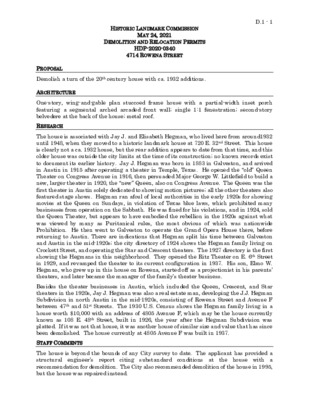
HISTORIC LANDMARK COMMISSION MAY 24, 2021 DEMOLITION AND RELOCATION PERMITS HDP-2020-0340 4714 ROWENA STREET D.1 - 1 PROPOSAL RESEARCH Demolish a turn of the 20th century house with ca. 1932 additions. ARCHITECTURE One-story, wing-and-gable plan stuccoed frame house with a partial-width inset porch featuring a segmental arched arcaded front wall; single 1:1 fenestration; second-story belvedere at the back of the house; metal roof. The house is associated with Jay J. and Elisabeth Hegman, who lived here from around1932 until 1948, when they moved to a historic landmark house at 720 E. 32nd Street. This house is clearly not a ca. 1932 house, but the rear addition appears to date from that time, and this older house was outside the city limits at the time of its construction; no known records exist to document its earlier history. Jay J. Hegman was born in 1883 in Galveston, and arrived in Austin in 1915 after operating a theater in Temple, Texas. He opened the “old” Queen Theater on Congress Avenue in 1916, then persuaded Major George W. Littlefield to build a new, larger theater in 1920, the “new” Queen, also on Congress Avenue. The Queen was the first theater in Austin solely dedicated to showing motion pictures; all the other theaters also featured stage shows. Hegman ran afoul of local authorities in the early 1920s for showing movies at the Queen on Sundays, in violation of Texas blue laws, which prohibited many businesses from operation on the Sabbath. He was fined for his violations, and in 1924, sold the Queen Theater, but appears to have embodied the rebellion in the 1920s against what was viewed by many as Puritanical rules, the most obvious of which was nationwide Prohibition. He then went to Galveston to operate the Grand Opera House there, before returning to Austin. There are indications that Hegman split his time between Galveston and Austin in the mid-1920s; the city directory of 1924 shows the Hegman family living on Crockett Street, and operating the Star and Crescent theaters. The 1927 directory is the first showing the Hegmans in this neighborhood. They opened the Ritz Theater on E. 6th Street in 1929, and revamped the theater to its current configuration in 1937. His son, Elmo W. Hegman, who grew up in this house on Rowena, started off as a projectionist in his parents’ theaters, and later became the manager of the family’s theater …
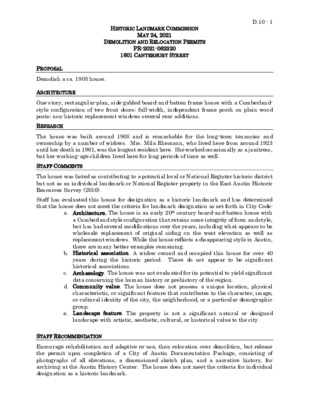
HISTORIC LANDMARK COMMISSION MAY 24, 2021 DEMOLITION AND RELOCATION PERMITS PR-2021-062320 1601 CANTERBURY STREET D.10 - 1 PROPOSAL Demolish a ca. 1908 house. ARCHITECTURE One-story, rectangular-plan, side-gabled board-and-batten frame house with a Cumberland- style configuration of two front doors; full-width, independent frame porch on plain wood posts; non-historic replacement windows several rear additions. RESEARCH STAFF COMMENTS The house was built around 1908 and is remarkable for the long-term tenancies and ownership by a number of widows. Mrs. Mila Rhemann, who lived here from around 1923 until her death in 1961, was the longest resident here. She worked occasionally as a janitress, but her working-age children lived here for long periods of time as well. The house was listed as contributing to a potential local or National Register historic district but not as an individual landmark or National Register property in the East Austin Historic Resources Survey (2016). Staff has evaluated this house for designation as a historic landmark and has determined that the house does not meet the criteria for landmark designation as set forth in City Code: a. Architecture. The house is an early 20th century board-and-batten house with a Cumberland style configuration that retains some integrity of form and style, but has had several modifications over the years, including what appears to be wholesale replacement of original siding on the west elevation as well as replacement windows. While the house reflects a disappearing style in Austin, there are many better examples remaining. b. Historical association. A widow owned and occupied this house for over 40 years during the historic period. There do not appear to be significant historical associations. c. Archaeology. The house was not evaluated for its potential to yield significant data concerning the human history or prehistory of the region. d. Community value. The house does not possess a unique location, physical characteristic, or significant feature that contributes to the character, image, or cultural identity of the city, the neighborhood, or a particular demographic group. e. Landscape feature. The property is not a significant natural or designed landscape with artistic, aesthetic, cultural, or historical value to the city. STAFF RECOMMENDATION Encourage rehabilitation and adaptive re-use, then relocation over demolition, but release the permit upon completion of a City of Austin Documentation Package, consisting of photographs of all elevations, a dimensioned sketch plan, and a narrative history, for archiving at the Austin History Center. The house does …
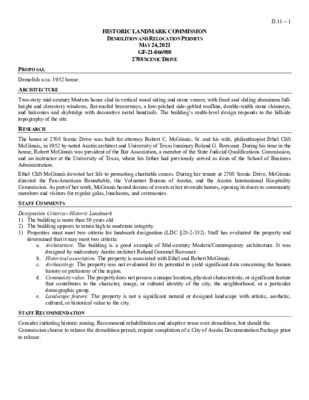
HISTORIC LANDMARK COMMISSION DEMOLITION AND RELOCATION PERMITS MAY 24, 2021 GF-21-066980 2708 SCENIC DRIVE D.11 – 1 PROPOSAL Demolish a ca. 1952 house. ARCHITECTURE RESEARCH Two-story mid-century Modern house clad in vertical wood siding and stone veneer, with fixed and sliding aluminum full- height and clerestory windows, flat-roofed breezeways, a low-pitched side-gabled roofline, double-width stone chimneys, and balconies and skybridge with decorative metal handrails. The building’s multi-level design responds to the hillside topography of the site. The house at 2708 Scenic Drive was built for attorney Robert C. McGinnis, Sr. and his wife, philanthropist Ethel Clift McGinnis, in 1952 by noted Austin architect and University of Texas luminary Roland G. Roessner. During his time in the house, Robert McGinnis was president of the Bar Association, a member of the State Judicial Qualifications Commission, and an instructor at the University of Texas, where his father had previously served as dean of the School of Business Administration. Ethel Clift McGinnis devoted her life to promoting charitable causes. During her tenure at 2708 Scenic Drive, McGinnis directed the Pan-American Roundtable, the Volunteer Bureau of Austin, and the Austin International Hospitality Commission. As part of her work, McGinnis hosted dozens of events at her riverside homes, opening its doors to community members and visitors for regular galas, luncheons, and ceremonies. STAFF COMMENTS Designation Criteria—Historic Landmark 1) The building is more than 50 years old. 2) The building appears to retain high to moderate integrity. 3) Properties must meet two criteria for landmark designation (LDC §25-2-352). Staff has evaluated the property and determined that it may meet two criteria: a. Architecture. The building is a good example of Mid-century Modern/Contemporary architecture. It was designed by midcentury Austin architect Roland Gommel Roessner. b. Historical association. The property is associated with Ethel and Robert McGinnis. c. Archaeology. The property was not evaluated for its potential to yield significant data concerning the human history or prehistory of the region. d. Community value. The property does not possess a unique location, physical characteristic, or significant feature that contributes to the character, image, or cultural identity of the city, the neighborhood, or a particular demographic group. e. Landscape feature. The property is not a significant natural or designed landscape with artistic, aesthetic, cultural, or historical value to the city. STAFF RECOMMENDATION Consider initiating historic zoning. Recommend rehabilitation and adaptive reuse over demolition, but should the Commission choose to release the …
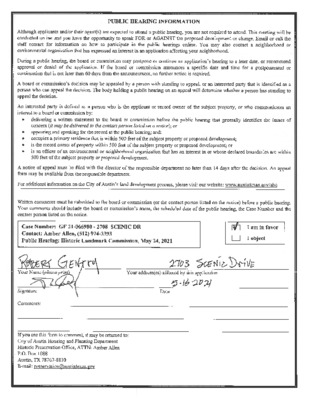
Backup
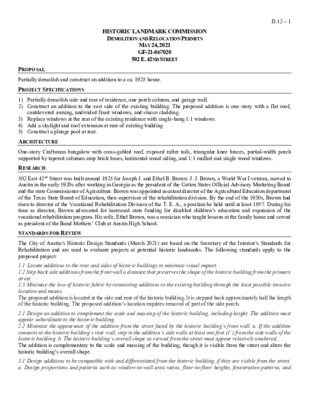
HISTORIC LANDMARK COMMISSION DEMOLITION AND RELOCATION PERMITS MAY 24, 2021 GF-21-067020 502 E. 42ND STREET D.12 – 1 PROPOSAL Partially demolish and construct an addition to a ca. 1925 house. PROJECT SPECIFICATIONS 1) Partially demolish side and rear of residence, one porch column, and garage wall. 2) Construct an addition to the east side of the existing building. The proposed addition is one story with a flat roof, cantilevered awning, undivided fixed windows, and stucco cladding. 3) Replace windows at the rear of the existing residence with single-hung 1:1 windows. 4) Add a skylight and roof extension at rear of existing building 5) Construct a plunge pool at rear. ARCHITECTURE RESEARCH One-story Craftsman bungalow with cross-gabled roof, exposed rafter tails, triangular knee braces, partial-width porch supported by tapered columns atop brick bases, horizontal wood siding, and 1:1 mulled and single wood windows. 502 East 42nd Street was built around 1925 for Joseph J. and Ethel B. Brown. J. J. Brown, a World War I veteran, moved to Austin in the early 1920s after working in Georgia as the president of the Cotton States Official Advisory Marketing Board and the state Commissioner of Agriculture. Brown was appointed assistant director of the Agricultural Education department of the Texas State Board of Education, then supervisor of the rehabilitation division. By the end of the 1930s, Brown had risen to director of the Vocational Rehabilitation Division of the T. E. A., a position he held until at least 1957. During his time as director, Brown advocated for increased state funding for disabled children’s education and expansion of the vocational rehabilitation program. His wife, Ethel Brown, was a musician who taught lessons at the family home and served as president of the Band Mothers’ Club at Austin High School. STANDARDS FOR REVIEW The City of Austin’s Historic Design Standards (March 2021) are based on the Secretary of the Interior’s Standards for Rehabilitation and are used to evaluate projects at potential historic landmarks. The following standards apply to the proposed project: 1.1 Locate additions to the rear and sides of historic buildings to minimize visual impact. 1.2 Step back side additions from the front wall a distance that preserves the shape of the historic building from the primary street. 1.5 Minimize the loss of historic fabric by connecting additions to the existing building through the least possible invasive location and means. The proposed addition is located …

GENERAL PROJECT NOTES GENERAL PROJECT NOTES 1. CONSTRUCTION DOCUMENTS MAKE NO WARRENT AS TO EXISTING CONDITIONS. CONTRACTOR IS RESPONSIBLE FOR FIELD VERIFYING ALL EXISTING CONSTRUCTION AND FRAMING PRIOR TO DEMOLITION AND CONSTRUCTION. CONTRACTOR IS RESPONSIBLE FOR COORDINATING ALL NEW CONSTRUCTION WITH EXISTING CONDITIONS. 2. THE CONTRACTOR SHALL FURNISH ALL LABOR, MATERIALS, TOOLS, EQUIPMENT, AND RELATED ITEMS REQUIRED TO COMPLETE THE DEMOLITION WORK AS INDICATED BY THE CONTRACT DOCUMENTS. 3. CONTRACTOR TO VERIFY ALL DIMENSIONS. REMOVE ALL MISCELLANEOUS DEVICES AS REQUIRED TO INSTALL NEW FINISHES, INCLUDING BUT NOT LIMITED TO: PLUMBING FIXTURES, SIGNAGE, SWITCH PLATES, TELEVISION BRACKETS, WALL OUTLET COVERS, TOILET ACCESSORIES, CORNER GUARDS, ETC. SAVE FOR REINSTALLATION AFTER COMPLETION OF FINISH WORK. PROTECT ALL EXISTING FINISHES, DOOR FRAMES, EQUIPMENT AND MATERIALS THAT ARE TO REMAIN IN PLACE. DAMAGE TO EXISTING COMPONENTS BY CONTRACTOR SHALL BE REPLACED WITH NEW MATERIAL OF LIKE KIND AND QUALITY THAT MATCH THE EXISTING STANDARDS. THE CONTRACTOR IS RESPONSIBLE FOR PREPARING EXISTING SURFACES TO RECEIVE NEW FINISHES SCHEDULED. 4. ALL ACCESSIBLE ROUTES (OTHER THAN RAMPS) SHALL NOT EXCEED A SLOPE OF 1:20, AND CROSS SLOPES SHALL NOT EXCEED A SLOPE OF 1:50 14 . PROTECT EXISTING VEGETATION, INCLUDING EXISTING TREES DURING CONSTRUCTION. REVEGETATE DAMAGED AREAS ADJACENT TO NEW CONSTRUCTION; CONTRACTOR SHALL MAINTAIN VEGETATED AREAS FOR 3 WEEKS AFTER INITIAL PLANTING 5. THE DRAWINGS INDICATE BUILDING CONDITIONS PER EXISTING DRAWINGS AND ACTUAL PROJECT INVESTIGATION. THE CONTRACTOR SHALL ANTICIPATE POSSIBLE SLIGHT DEVIATION FROM THESE DRAWINGS. REFER TO ARCHITECTURAL & MEP DRAWINGS AND DETAILS FOR EXTENT OF DEMOLITION. 6. THE CONTRACTOR SHALL SUPERVISE AND DIRECT THE WORK, USING HIS BEST SKILL AND ATTENTION. HE SHALL BE SOLELY RESPONSIBLE FOR ALL MEANS, METHODS, TECHNIQUES, SEQUENCES AND PROCEDURES AND FOR COORDINATING ALL PORTIONS OF THE WORK UNDER THE CONTRACT. 7. INSTALL TEMPORARY DUST PARTITIONS WITH DOORS FOR CONSTRUCTION ACCESS AROUND AREAS OF WORK SO THAT OPERATIONS IN EXISTING ADJACENT AREAS REMAIN DUST FREE AND ACCESSIBLE TO BUILDING OCCUPANTS. MAINTAIN IN PLACE UNTIL COMPLETION OF CONSTRUCTION. 8. REMOVE ALL BUILDING PARTS AND/OR OTHER ITEMS TO ALLOW FOR THE INSTALLATION AND CONNECTION OF NEW WORK, COORDINATE THE WORK WITH THE HVAC, PLUMBING AND ELECTRICAL DEMOLITION DRAWINGS. 9. REMOVAL OF THE BUILDING PARTS SHALL BE PERFORMED IN A SAFE, ORDERLY AND CAREFUL MANNER, WITH THE CONSIDERATION AT ALL TIMES FOR THE SAFETY AND WELFARE OF THE OWNER, BLDG. OCCUPANTS, & PERSONNEL OF THE CONTRACTOR AND/OR SUBCONTRACTOR. 10 . 11 . MAINTAIN THE UTILITIES TO …

HISTORIC LANDMARK COMMISSION DEMOLITION AND RELOCATION PERMITS MAY 24, 2021 PR-2021-063853; GF-2021-067031 1109 TRAVIS HEIGHTS BLVD. D.13 – 1 PROPOSAL Partially demolish ca. 1920 house; remove aluminum siding and restore stucco exterior; remove existing rear addition and construct new rear addition with covered porch and roof deck. PROJECT SPECIFICATIONS will be clad in horizontal siding. 1) Removal of a non-historic two-story rear addition and construction of a new rear addition with a roof deck. The addition 2) Removal of aluminum siding and repair of plaster on the house and porch columns. 3) Restoration of most existing windows; installation of new double-hung windows in some openings of the house and on 4) Construction of a covered porch with exterior brick fireplace and chimney to the side of the rear addition. The front of the porch will be set back 29’-5 ½” and the outdoor fireplace 54’-6” from the façade of the house. 5) Slight enlargement of and siding replacement on the existing detached garage. the addition. ARCHITECTURE This American Foursquare house with Prairie School stylistic influences was constructed ca. 1920. The two-story house has a low-pitched hipped roof with broad overhangs. The full-width, hipped-roof porch has a long, open span supported at the corners by large square columns. The second floor had recessed corners that been infilled and converted to interior space. Originally clad in stucco, much of the house has been covered with aluminum siding. Wood double-hung windows have multiple lights in the top sash or are 1:1 light. The front elevation has a central grouping of four 8:1 light windows on the second floor. The side elevation, facing Harwood Pl., has a projecting sleeping porch with 6:1 light windows below a central grouping of five 1:1 light windows on the second floor. RESEARCH Early owners of this ca. 1920 house were Elmer E. and Cora Young. E. E. Young was co-owner of an automotive dealership, Hart & Young, Willys-Knight and Overland Austin Agency; he later bought out his partner and continued operation under his name. He served as president of the local automobile dealers’ association. Shortly before his death in 1928, Young became secretary of the Stacy Realty Company, developer of the Travis Heights neighborhood. Charles J. and Katherine Brunner owned the house from 1929 until 1947. Charles Brunner operated a jewelry business on East Sixth St. beginning in the late 1890s. After his death in 1933, Katherine Brunner …
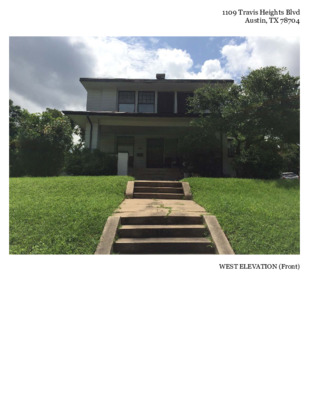
WEST ELEVATION (Front) 1109 Travis Heights BlvdAustin, TX 78704 SOUTH ELEVATION 1109 Travis Heights BlvdAustin, TX 78704 APPROX. LOCATION OF ADDITION TO BE REMOVED EAST ELEVATION 1109 Travis Heights BlvdAustin, TX 78704 NORTH ELEVATION LOCATION OF ADDITION TO BE REMOVED 1109 Travis Heights BlvdAustin, TX 78704
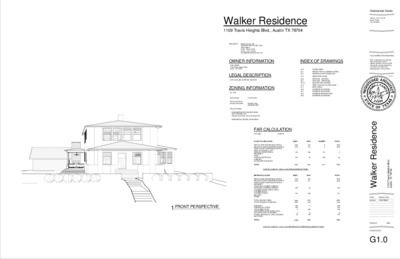
Walker Residence 1109 Travis Heights Blvd., Austin TX 78704 OWNER INFORMATION INDEX OF DRAWINGS G1.0 G1.1 G3.1 D1.0 A0.0 A0.1 A0.1a A1.0 A1.1 A2.0 A2.1 A2.3 A2.4 COVER SHEET PROJECT INFO & GENERAL NOTES WINDOW & DOOR SCHEDULES DEMOLITION PLANS SITE PLAN - EXISTING SITE PLAN - PROPOSED BUILDING TENT EXHIBIT FIRST & SECOND FLOOR PLANS ROOF PLANS EXTERIOR ELEVATIONS EXTERIOR ELEVATIONS EXTERIOR PERSPECTIVES EXTERIOR ELEVATIONS ARCHITECT: Norma Yancey, AIA SIDETRACKED STUDIO, PLLC 1806 Holly St. Austin, Texas 78702 phone: 512.774.4261 norma@sidetracked-studio.com Adam Walker 1109 Travis Heights Blvd. Austin, TX 78704 LEGAL DESCRIPTION LOT 31&32 BLK 28 TRAVIS HEIGHTS ZONING INFORMATION SF-3-NP Zoning Case: C14-05-0139 Zoning Ordinance (Mostly after 2000): Zoning Overlays: 99-0225-70(b) 20050929-Z003 NEIGHBORHOOD PLANNING AREA SOUTH RIVER CITY Greater South River City Combined NPA RESIDENTIAL DESIGN STANDARDS FLOOR TO AREA RATIO: EXIST. NEW EXEMPT TOTAL 3,385 SF/ 13,996 SF = 24.2% < 40% FAR ALLOWED BY CODE 1354 1211 IMPERVIOUS COVER: EXIST. NEW TOTAL FAR CALCULATION LOT SIZE: 13,996 SF FIRST FLOOR CONDITIONED SPACE: SECOND FLOOR CONDITIONED SPACE: THIRD FLOOR CONDITIONED SPACE: AREA W/ CEILINGS >15FT: GROUND FLOOR PORCH: BASEMENT: ATTIC: GARAGE (DETACHED): CARPORT: ACCESSORY BUILDINGS: TOTAL: FIRST FLOOR CONDITIONED SPACE: SECOND FLOOR CONDITIONED SPACE: THIRD FLOOR CONDITIONED SPACE: BASEMENT: ATTACHED COVERED PARKING: DETACHED COVERED PARKING: COVERED WOOD DECKS (100%): COVERED PATIO: COVERED PORCH: BALCONY: OTHER: TOTAL BUILDING AREA: TOTAL BUILDING COVERAGE: DRIVEWAY: SIDEWALKS & STEPS: UNCOVERED PATIO: UNCOVERED WOOD DECKS (50%): AC PADS & CONC FLATWORK: OTHER: SITE WALLS, CONC LANDINGS AND STEPS 1256 1079 - - 416 - - 491 - - 3242 1256 1079 - - - 491 - - 416 - - 3242 2163 699 232 0 - 0 32 544 411 - - 345 - - 54 - - 544 411 - - - 54 - - 345 - - 1354 943 0 - 259 - 18 119 TOTAL: 3126 1339 4,465 SF/ 13,996 SF = 31.9% < 45% IMPERVIOUS COVERAGE ALLOWED BY CODE 0 0 - - 761 - - 450 - - 1800 1490 - - 0 - - 95 - - 3385 1800 1490 - - - 545 - - 761 - - 4596 3106 699 232 259 - 18 151 4465 Sidetracked Studio 1605 E. 7th St. Unit B Austin, Texas 512 220 6865 FIELD INSPECTION REQUIRED Prior to performing any bidding, new construction, and/or repairs, general contractor shall visit the site, inspect all existing conditions, and report any …
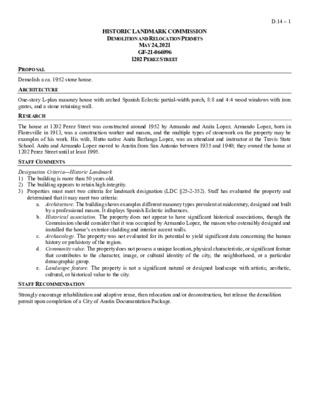
HISTORIC LANDMARK COMMISSION DEMOLITION AND RELOCATION PERMITS MAY 24, 2021 GF-21-064096 1202 PEREZ STREET D.14 – 1 PROPOSAL Demolish a ca. 1952 stone house. ARCHITECTURE RESEARCH One-story L-plan masonry house with arched Spanish Eclectic partial-width porch, 8:8 and 4:4 wood windows with iron grates, and a stone retaining wall. The house at 1202 Perez Street was constructed around 1952 by Armando and Anita Lopez. Armando Lopez, born in Floresville in 1913, was a construction worker and mason, and the multiple types of stonework on the property may be examples of his work. His wife, Hutto native Anita Berlanga Lopez, was an attendant and instructor at the Travis State School. Anita and Armando Lopez moved to Austin from San Antonio between 1935 and 1940; they owned the home at 1202 Perez Street until at least 1995. STAFF COMMENTS Designation Criteria—Historic Landmark 1) The building is more than 50 years old. 2) The building appears to retain high integrity. 3) Properties must meet two criteria for landmark designation (LDC §25-2-352). Staff has evaluated the property and determined that it may meet two criteria: a. Architecture. The building shows examples different masonry types prevalent at midcentury, designed and built by a professional mason. It displays Spanish Eclectic influences. b. Historical association. The property does not appear to have significant historical associations, though the Commission should consider that it was occupied by Armando Lopez, the mason who ostensibly designed and installed the home’s exterior cladding and interior accent walls. c. Archaeology. The property was not evaluated for its potential to yield significant data concerning the human history or prehistory of the region. d. Community value. The property does not possess a unique location, physical characteristic, or significant feature that contributes to the character, image, or cultural identity of the city, the neighborhood, or a particular demographic group. e. Landscape feature. The property is not a significant natural or designed landscape with artistic, aesthetic, cultural, or historical value to the city. STAFF RECOMMENDATION Strongly encourage rehabilitation and adaptive reuse, then relocation and/or deconstruction, but release the demolition permit upon completion of a City of Austin Documentation Package. LOCATION MAP D.14 – 2 PROPERTY INFORMATION Photos D.14 – 3 D.14 – 4 Realtor.com, 2021 Google Street View, 2021 Occupancy History City Directory Research, April 2021 1959 Armando Lopez, owner 1957 Armando B. and Anita B. Lopez, owners Rock mason 1955 Armando and Anita Lopez, owners Construction …

HISTORIC LANDMARK COMMISSION DEMOLITION AND RELOCATION PERMITS MAY 24, 2021 HR-2021 044092 2040 EAST CESAR CHAVEZ STREET D.2 – 1 PROPOSAL Demolish a ca. 1926-27 house. ARCHITECTURE RESEARCH One-story National Folk residence clad in board-and-batten siding. It features a pyramidal hipped roof clad in corrugated metal, exposed rafter tails, an inset partial-width porch supported by boxed columns, and screened 1:1 windows. The house at 2040 East Cesar Chavez Street was constructed around 1927 by Christian and Charlotte Kofahl for their family. The Kofahls were both born in Oldsloe, Germany and settled in Austin in 1878; Christian Kofahl was a successful barber and operated several barbershops and ladies’ hair salons, including for the Driskill. Kofahl was an active member of the German Lutheran church, serving as one of the first elders of St. Martin’s Evangelical Lutheran Church; the organization’s first building of worship was constructed in 1885 on land donated by Christian Kofahl. Kofahl died in 1930, and his family vacated the home. From 1932 into the 1940s, the property became primarily a rental house, with short-term residents including electricians, mechanics, salesmen, and bookkeepers. During the 1940s, it was occupied by a serviceman, a firefighter, and a driver and their families. By 1954, Otis Roe lived in the home and operated his service station across the street at 2027 East Cesar Chavez Street. In 1957, Albert G. and Zelma Gonzales purchased the house; they sold it two years later to Rosa M. Gillian. STAFF COMMENTS The 2016 East Austin historic resource survey lists the property as eligible for local landmark designation and individual listing on the National Register of Historic Places, as well as contributing to a potential local historic district and contributing to a potential National Register Historic District. The survey lists architecture and historical associations as qualifying NRHP criteria. Designation Criteria—Historic Landmark 1) The building is more than 50 years old. 2) The building appears to retain high to moderate integrity. 3) Properties must meet two criteria for landmark designation (LDC §25-2-352). Staff has evaluated the property and determined that it may meet two criteria: a. Architecture. The building is constructed in the National Folk style. b. Historical association. The East Austin survey identifies the property’s occupancy history as an example of demographic changes and settlement patterns among working- to middle-class renters in East Austin during the twentieth century. c. Archaeology. The property was not evaluated for its potential …

From: Subject: Date: Kalan, Contreras, Kalan 2040 E Cesar Chavez - demolition permit application Wednesday, May 19, 2021 5:55:11 PM *** External Email - Exercise Caution *** This demolition permit application is scheduled for the next historic review meeting on Monday, May 24. I will be out of town, so am unable to attend. I would like to explain the necessity for the demolition. The house is in disrepair and poses a liability and financial hazard if it remains. The owner's insurance company will no longer insure the property. Therefore, if anything happens to the property or a person on the property, the owner is at risk. She has tried to keep up with the home over the years but does not have the means to get it to an insurable state. The structure, including the floor and roof framing, is deteriorated beyond repair. It would need to be completely rebuilt. I've attached some pictures. I would like this information shared along with the pictures at the historical meeting. Please let me know if I need to send a formal letter. Thank you and have a great day. -- CAUTION: This email was received at the City of Austin, from an EXTERNAL source. Please use caution when clicking links or opening attachments. If you believe this to be a malicious and/or phishing email, please forward this email to cybersecurity@austintexas.gov.